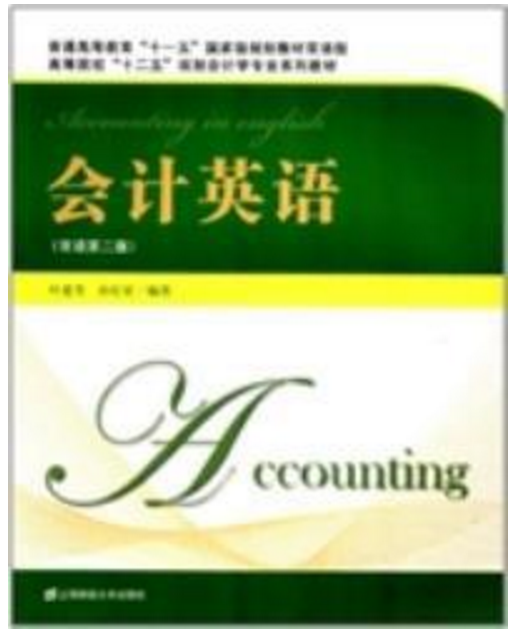《會計英語(雙語第二版)》是2012年8月1日上海財經大學出版社出版的圖書,作者是葉建芳、孫紅星。
基本介紹
- 書名:會計英語(雙語第二版)
- 作者:葉建芳、孫紅星
- ISBN:978-7-5642-1448-7/F.1448
- 出版社:上海財經大學出版社
- 出版時間:2012年8月1日
- 開本:16開
- 責任編輯:王永長
內容簡介,圖書目錄,
內容簡介
《會計英語》(雙語簡明版)出版兩年多以來,重印了三次,銷售一萬多冊,獲得了廣大教師和學生的一致好評。本書作為“十一五”國家級規劃教材《會計英語》的雙語版,秉承了其特點,結構上仍然分為九章:第一至第三章是對會計的性質以及會計信息產生過程的敘述;第四至第八章是關於資產、負債和所有者權益的確認、計量和報告;第九章是關於有關企業經營活動對現金流量表的影響,以及如何編制現金流量表。儘管第二版結構上沒有較大變化,但是內容還是做了一些修訂,尤其是對會計政策的變化做了調整,更加符合現行的會計政策,在教學上適應教學需要,在實務中符合操作的要求。 在教材修訂的同時,我們對教學課件(PPT)和中文翻譯也同時作了調整,保持與第二版教材的適應性與同步性。 第二版依然保留了每一章的自測題、練習題、問題,方便讀者通過練習,掌握所學內容。自測題答案在每一章的最後一頁,練習題和問題的參考答案在書本的最後附錄中。
圖書目錄
Chapter 1 An Introduction to Accounting
1.1 Accounting is an Information System
1.2 Forms of Organization
1.3 The Framework for the Preparation and Presentation of Financial Statements
1.4 Understanding of Financial Statements
1.5 Accounting and Its Profession
1.6 Accounting Elements and Using the Accounting Equation
1.7 Professional Ethics in Accounting
1.8 Convergence of Accounting Standards Chinese Accounting Standards: Development and Implementation
Vocabulary
Self—test Questions
Exercises
Answers to Self—test Questions
Chapter 2 Accounting Cycle
2.1 T—account and Debit & Credit
2.2 Journalizing and Posting Transactions
2.3 Preparing a Trial Balance
2.4 Adjusting the Accounts
2.5 Adjusted Trial Balance and Preparation of Financial Statements
2.6 The Worksheet
2.7 Closing
2.8 The Accounting Cycle Summary
2.9 Classification of Balance Sheet Items
Vocabulary
Self—test Questions
Exercises
Answers to Self—test Questions
Chapter 3 Current Assets
3.1 Cash
3.2 Trading Securities
3.3 Notes Receivable
3.4 Accounts Receivable
3.5 Inventories
Vocabulary
Self—test Questions
Exercises
Answers to Self—test Questions
Chapter 4 Non—current Assets
4.1 Fixed Assets
4.2 Natural Resources
4.3 Intangible Assets
4.4 Impairment of Fixed Assets
4.5 Long—term Investments
4.6 Impairment of Long—term Investments
Vocabulary
Self—test Questions
Exercises
Answers to Self—test Questions
Chapter 5 Liabilities
5.1 Current Liabilities
5.2 Non—current Liabilities
Vocabulary
Self—test Questions
Exercises
Answers to Self—test Questions
Chapter 6 Owners' Equity
6.1 Forms of Organization
6.2 Stockholders' Rights
6.3 Accounting for Stock Issues
6.4 Treasury Stock
6.5 Preferred Stock
6.6 Dividends and Stock Splits
6.7 Accounting for Retained Earnings
6.8 Statement Presentation and Analysis
Vocabulary
Self—test Questions
Exercises
Answers to Self—test Questions
Chapter 7 Revenue and Expense Recognition and Income Statement Presentation
7.1 Revenue Recognition Concepts
7.2 Revenue Recognition at Delivery
7.3 Revenue Recognition before Delivery
7.4 Revenue Recognition after Delivery
7.5 Long—term Contracts
7.6 Revenue Recognition for Service Sales
7.7 Recognition of Gains and Losses
7.8 Expense Recognition
7.9 Presentation of the Income Statement
Vocabulary
Self—test Questions
Exercises
Answers to Self—test Questions
Chapter 8 Statement of Cash Flows and Financial Statement Analysis
8.1 Cash and Cash Equivalents
8.2 Classification of Cash Receipts and Cash Payments
8.3 Preparing Statement of Cash Flows——Direct Method
8.4 Preparing Statement of Cash Flows——Indirect Method
8.5 Determining Cash Flows from Investing Activities
8.6 Determining Cash Flows from Financing Activities
8.7 Presenting the Information in the Form of the Statementof Cash Flows
8.8 Usefulness of the Statement of Cash Flows
8.9 Financial Statement Analysis: Horizontal and Vertical
8.10 Ratio Analysis
Vocabulary
Self—test Questions
Exercises
Answers to Self—test Questions
Appendix
1.Balance Sheet
2.Income Statement
3.Statement of Changes in Owners' Equity
4.Statement of Cash Flows
5.The Disclosure of Supplementary Information to Statement of Cash Flows
6.Disclosure of Information and Accounts Required
7.VAT Return Form
8.Consumption Tax Return Form
9.Business Tax Return Form
10.Annual Return Form of The People' s Republic of China on Corporate Income Tax
11.Individual Income Tax Return Form

